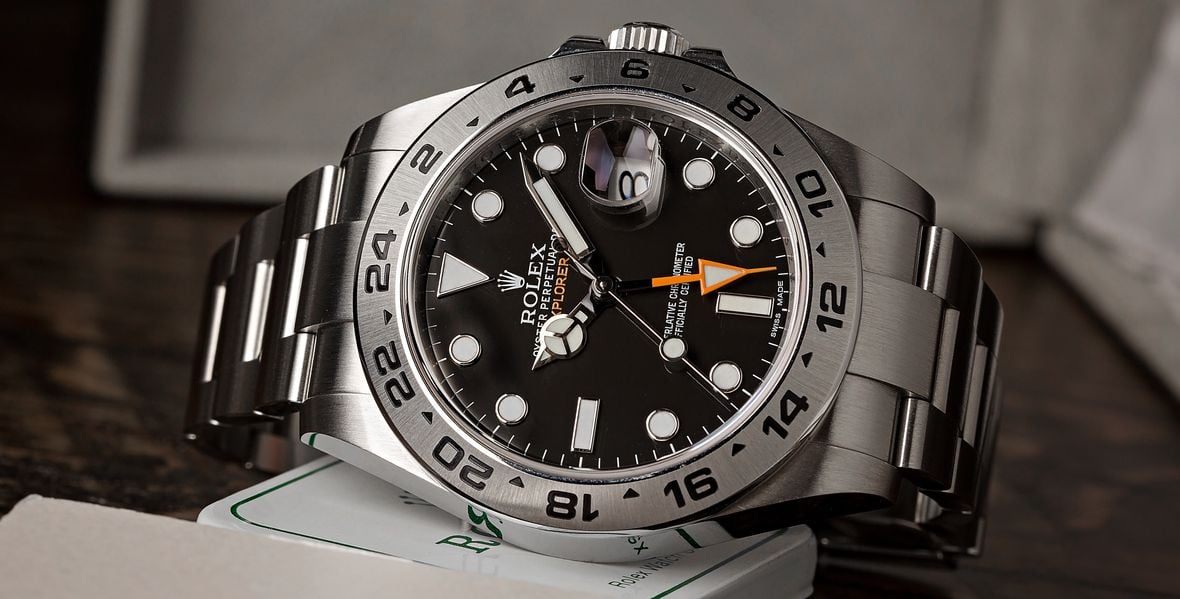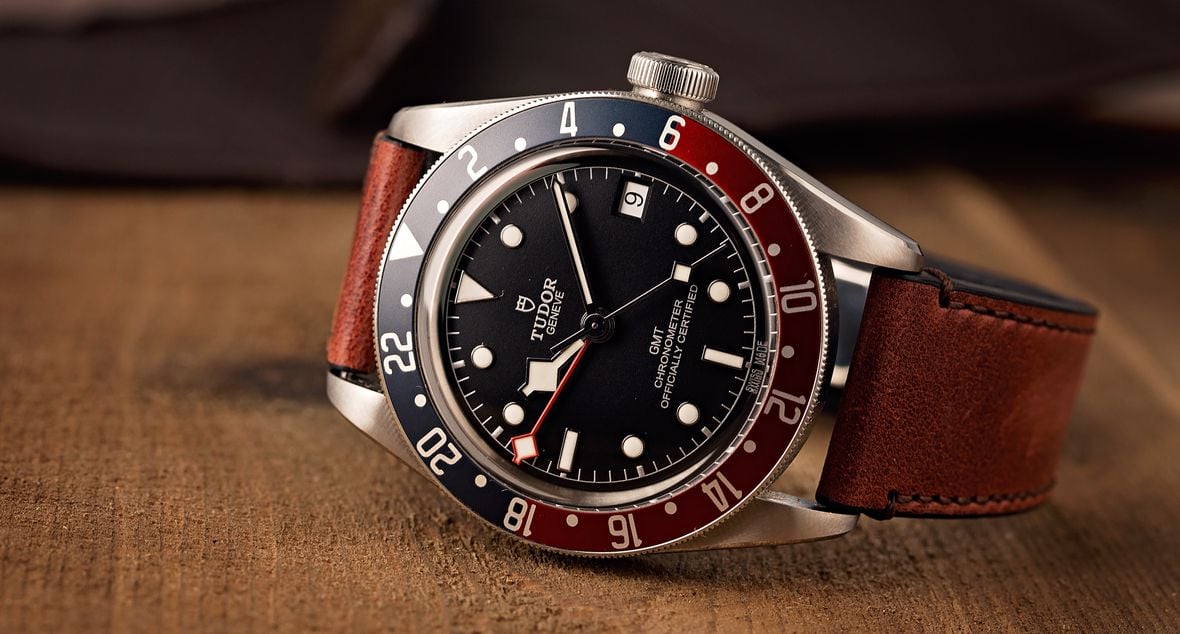When the Rolex Daytona first appeared in 1963, it was far from the ultra-desirable status symbol it is today. The model’s ascent to iconic status began in the late 1980s with the introduction of a self-winding movement, marking the start of its transformation into one of the most sought-after sports watches of the 21st century.
Today, the Cosmograph Daytona has evolved into one of the most diverse and coveted collections in Rolex’s lineup. With a wide range of materials, from 18k yellow, white, and Everose gold (Rolex’s proprietary blend of 18k rose gold) to stainless steel and platinum, the Daytona offers a multitude of options, including various bezels, bracelets, and dial designs.
Amid this variety, one particular model stands out for its sheer opulence and exclusivity: the Rolex Daytona Rainbow. A true statement piece, the Rainbow Daytona is not just a watch but a dazzling showcase of Rolex’s craftsmanship and expertise in both watchmaking and gem-setting. Below, we delve into the details of this extraordinary timepiece.
Rolex Daytona Rainbow Specifications
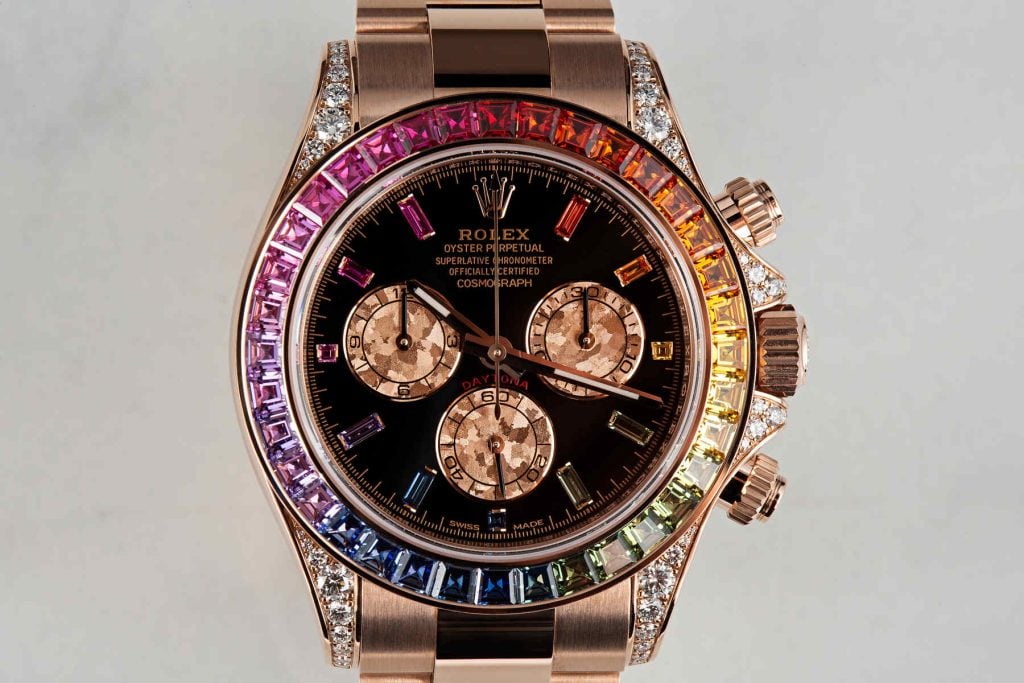
The Rolex Daytona Rainbow watch combines the precision and reliability Rolex is known for with a bold, eye-catching design that is truly one-of-a-kind. The Rainbow Daytona stands out in the world of luxury watches with its vibrant, multi-colored sapphires set around the bezel, representing the full spectrum of a rainbow, making it a coveted piece among collectors and enthusiasts alike.
Crafted in 18k gold, available in yellow, white, or Everose, the Rainbow Daytona’s 40mm case is both robust and elegant. The dial, offered in black or diamond pavé, further enhances the watch’s luxurious appeal, with crystal gold registers and hour markers made from either baguette-cut sapphires or square-cut diamonds. These details not only elevate the watch’s visual appeal but also underscore Rolex’s commitment to excellence, with a focus on intricate craftsmanship and premium materials.
Beneath its stunning exterior, the Rolex Daytona Rainbow is powered by the reliable Rolex Caliber 4130, ensuring accurate timekeeping and smooth operation of its 12-hour chronograph function. The watch features a flat sapphire crystal for protection, is water-resistant up to 100 meters, and is paired with the iconic Oyster bracelet, providing both comfort and a secure fit. This combination of technical prowess and dazzling design makes the Rainbow Daytona a masterpiece in the world of horology.
Technical Highlights of the Rolex Daytona Rainbow:
- Reference Numbers: 116598RBOW, 116599RBOW, 116595RBOW
- Case Diameter: 40mm
- Materials: 18k Gold (Yellow, White, or Everose Gold)
- Functions: Time w/ Running Seconds, 12-Hour Chronograph
- Dial: Black or Diamond Pavé w/ Crystal Gold Registers and Baguette-Cut Sapphire or Square-Cut Diamond Hour Markers
- Bezel: Fixed, 36 Baguette-Cut Rainbow Gradated Sapphires
- Crystal: Sapphire (Flat)
- Water Resistance: 100 Meters / 330 Feet
- Movement: Rolex Caliber 4130
- Strap/Bracelet: Oyster Bracelet
Rolex Rainbow Daytona Case & Bracelet
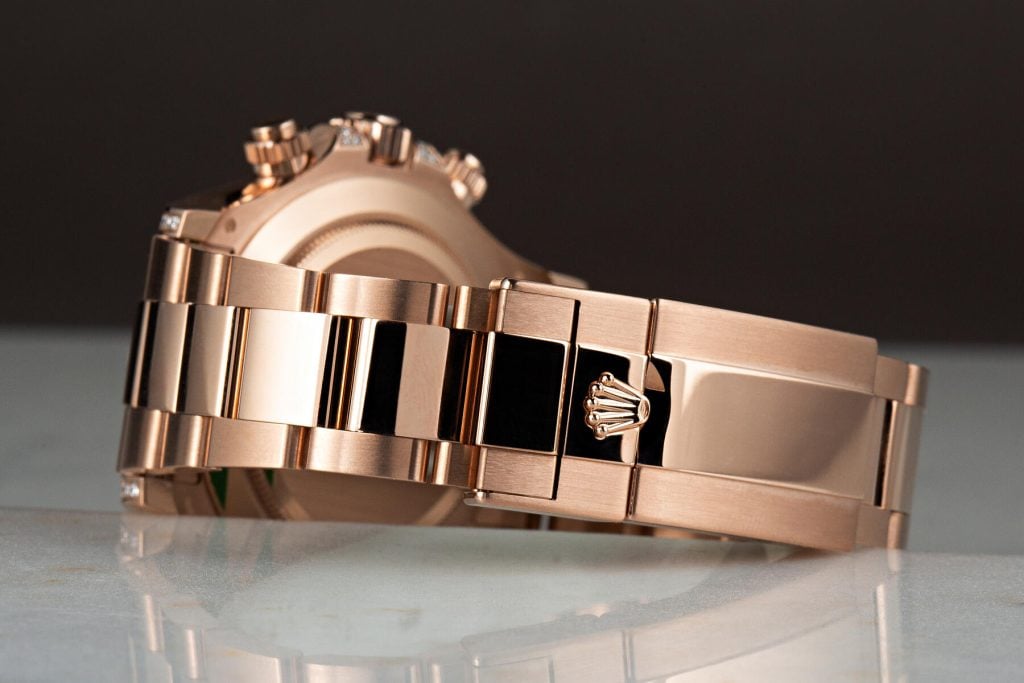
In truth, the Rolex Daytona has always had a bit of a flashy side, especially for what started out (ostensibly) as a tool watch. Unlike, say, the Submariner or Explorer, there has been a solid gold option for nearly every one of its references dating back to its initial debut in 1963.
Furthermore, diamond-encrusted bezels made their first appearance as early as the 1980s, with the ref. 6269 and ref. 6270 (featuring brilliant-cut and baguette-cut stones respectively), completely negating the speed measuring abilities of its tachymeter scale – what is typically one of the Daytona’s hallmark characteristics. However, those vintage examples now look positively tame next to the Rainbow models.
The yellow and white gold Cosmograph Daytona Rainbow watches hit the market in 2012, with another six years going by until the 2018 release of the Everose gold version. As of yet, there has not been a platinum version, but with price being virtually no object for the buyers of these watches, it is certainly not something to rule out for the future.
Visually, all of the Rolex Daytona Rainbow watches follow a similar pattern, although there are slight differences between the two older models and the more recent Everose gold edition. The lugs and crown guards on each reference are coated with 56 brilliant-cut diamonds, varying in size depending on their positioning. ‘Brilliant’ refers to a stone cut into a cone shape with numerous facets, designed to let as much light through as possible and so provide exceptional brilliance – and the gems festooning the Rainbow Daytona’s extremities do indeed dazzle.
Rolex Rainbow Daytona Dial & Bezel
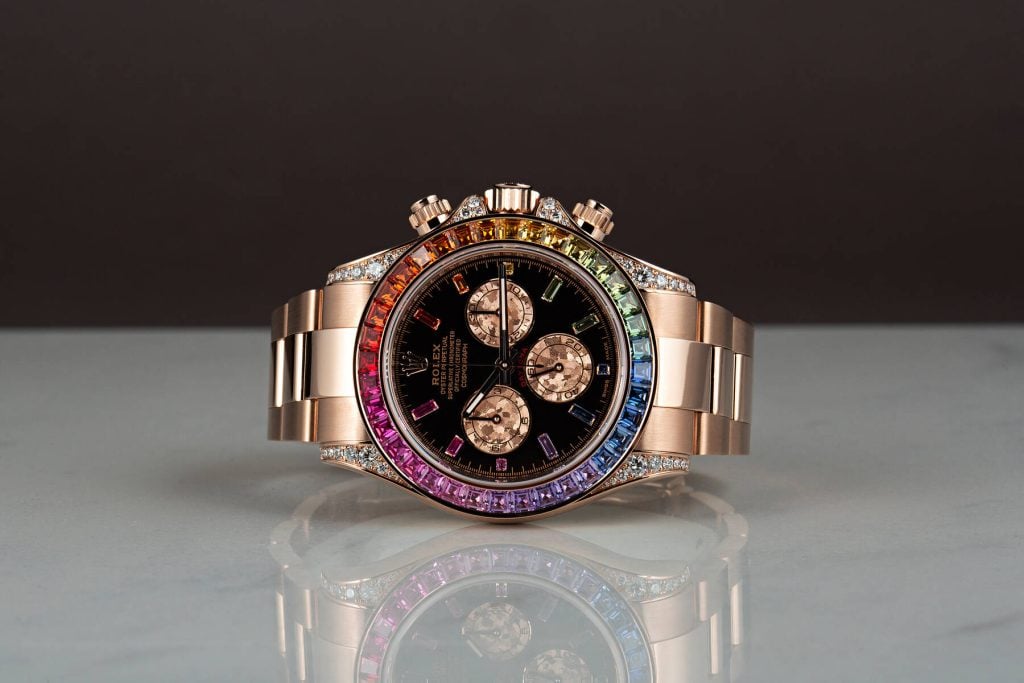
Moving away from the case and onto the dial is where we see the small but intriguing disparities. The yellow gold (ref. 116598RBOW) and white gold (116599RBOW) models each have eight further brilliant-cut diamonds, placed in square settings for their hour markers, with the 3, 6, and 9 o’clock locations receiving applied Arabic numerals and the Rolex coronet standing in for the 12 o’clock marker.
However, on the most recent Everose gold Rainbow Daytona ref. 116595RBOW, those diamonds have been replaced by sapphires, in a mixture of colored baguette and square-cut shapes (depending on how much space each one has on the dial). So, why is that important? To answer that, we have to bring the truly extraordinary bezel into focus.
The Rolex Rainbow Daytona watches obviously got their name from the 36 multicolored gems adorning their bezels. The reason these rainbow-colored gemstone bezels are so special is the unbelievable fastidiousness the setters have shown in selecting exactly the right stones. In addition to complete uniformity in terms of size, shape, and quality, the graduation in color from one stone to the next is absolutely seamless, and something that is only really possible when backed by the immense resources of the world’s most famous watchmaker.
With that in mind, the Everose gold version takes the significant extra step of having its baguette-cut sapphire indexes precisely mirroring the shade of the adjacent stone on the bezel. It is a stunning achievement and even if the watch itself isn’t to your taste, it’s impossible not to be impressed with the dedication and expertise that has clearly gone into each one.
It also explains why all three of the Rainbow Daytona watches were produced in such tiny numbers. Even with Rolex’s funding, there are only so many suitable gems in the world, and only so many gemologists capable of selecting and setting these stunning multicolor stones.
There are also a couple of other differences between the different black dial Rainbow Daytona models. The three chronograph counters, in their traditional tri-compax arrangement, are finished in what Rolex has dubbed gold crystal. The term refers to a gold alloy that has been crystallized to give it a textured aesthetic, and each of these Rainbow Daytona models receives sub-dials color-matched to the gold of its case. Lastly, only the Everose edition is given the extra blingy option of a full diamond pavé dial, which is drenched in diamonds that carry over onto the center links of its Oyster bracelet.
Rolex Rainbow Daytona Movement
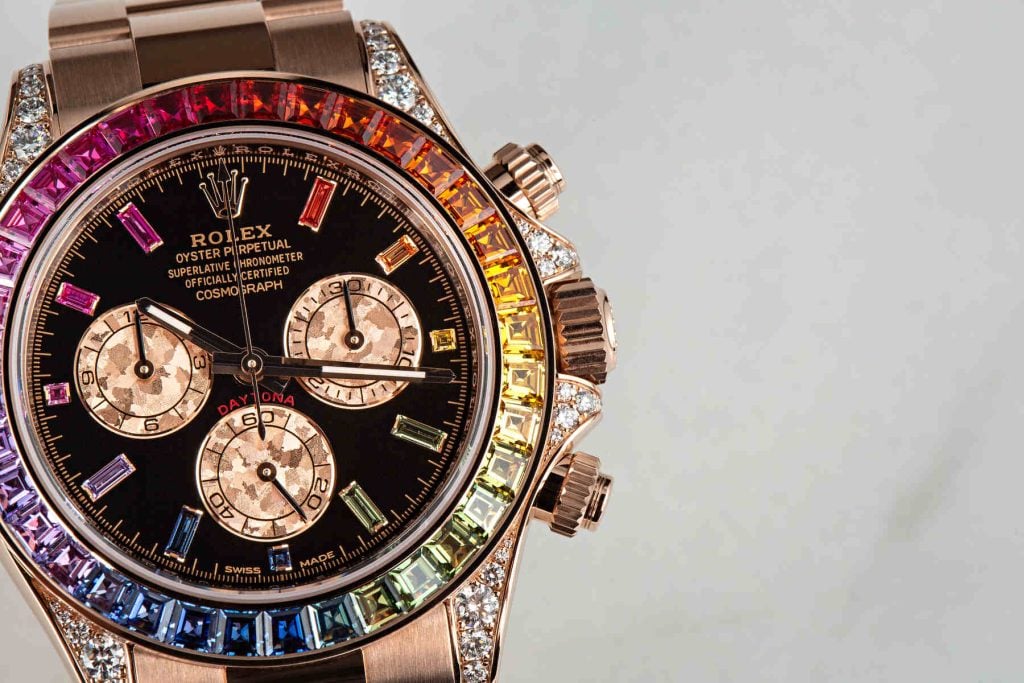
Underneath all the extravagant grandstanding, at their heart, these watches are still part of the Rolex Daytona collection, arguably the greatest mechanical stopwatch of all time.
And running the show is the in-house Caliber 4130 movement. It is the entirely Rolex-produced follow-on from the Zenith El Primero, the Daytona’s first automatic caliber, and is recognized as one of the finest mass-produced chronograph movements of the modern era.
The Cal. 4130 was unveiled in 2000 after 5-years of development, and it followed Rolex’s customary decree of doing more with less. Made up of just 201 separate parts (representing a 60% decrease from its predecessor), it has been stripped back to just its essential components for maximum reliability.
In places, Rolex’s engineers have consolidated several different elements into one. For example, while the previous movement had two individual mechanisms to control the minute and hour chronograph counters (one on each side of the movement), on the Caliber 4130 they have been combined into a single module. In addition to meaning that the chronograph can now be adjusted with a lone regulating screw rather than the five of the El Primero, it frees up enough room for a longer mainspring, taking the power reserve from 50 to 72 hours.
The Cal. 4130 was also the first Rolex movement to receive the brand’s proprietary Parachrom hairspring. The alloy of niobium and zirconium with a blue oxide coating is of Rolex’s own invention and it is virtually impervious to the effects of magnetism and temperature variations, two of the biggest enemies to mechanical movements and their accuracy. Shock resistance is likewise reported to have increased, by as much as 10 times over older traditional hairsprings.
Perhaps the most important of all the various improvements is the adoption of a vertical clutch for the chronograph. Along with granting the ability to run the stopwatch for extended periods of time without affecting the model’s general timekeeping, it has the advantage of providing incredibly precise starts and stops of the seconds hand, without the judder or ‘handslop’ that is sometimes associated with the more-common horizontal coupling system.
Additionally, Rolex has made the clutch unit serviceable, unlike those of many other rival manufacturers. The module can be removed, disassembled, lubricated, and replaced with relative ease, both safeguarding its accuracy and extending the life of its components. All of the Rainbow Daytona watches are classified as Superlative Chronometers, which means that they exceed the already-stringent timekeeping parameters that are required for COSC-certification (the gold standard when it comes to movement accuracy).
Rolex Daytona Rainbow Price
Upon their release, the various Rainbow Daytona watches represented some of the most expensive models Rolex had ever put into production. The Everose gold version, due in part to its color-coded indexes, was the most expensive retailing at around $97,500, with the yellow and white gold pieces still topping the $90,000 mark. However, the value of these watches on the pre-owned market has absolutely skyrocketed.
Given that Rolex Daytona Rainbow watches feature solid 18k gold cases swathed in the finest jewels, they were always going to be somewhat costly. Additionally, buying one of these Rolex models was already scarce to begin with and are only getting increasingly more difficult to track down as an increasing number of people seek to add them to their collections. Consequently, the average asking price for a Rolex Daytona Rainbow is now almost triple what it was when the watches were originally launched.
At the absolute bare minimum, you will be parting with northwards of $400,000 for any of the three Rainbow Daytona watches. And if you fancied securing yourself the mega-luxurious diamond pavé dial Everose gold versions, plan on spending roughly twice that. It is not uncommon for Rolex watches to sell for three to four times their original retail prices, but there is a significant difference between a watch that costs $5k to $10k selling for triple its retail price, and one that already costs almost six figures doing the same.
Who Wears The Rainbow Daytona?
The list of celebrities who have embraced the Rolex Rainbow Daytona is a diverse one, although they do all have one particular trait in common – and that is a less than shy and retiring personality.
Rapper, singer, and producer Post Malone is a big fan of the Rainbow Daytona, as are fellow musicians and fanatical horologists John Mayer and Adam Levine. Actor and comedian Kevin Hart and tough guy Mark Wahlberg also share a love for the colorful excesses of the Rainbow Daytona, and even Miley Cyrus has been spotted wearing her yellow gold model.
From the world of sports, Kansas City Chiefs quarterback, Patrick Mahomes flexes the Everose gold edition, along with LA Lakers power forward, Anthony Davis. Additionally, French soccer star, Antoine Griezmann decided to celebrate his move to Barcelona from Atlético Madrid by purchasing himself an Everose gold Rainbow Daytona.
However, perhaps topping them all is legendary Cameroonian striker Samuel Eto’o. His Rainbow Daytona is rumored to have been specially commissioned by Rolex, and it is the only white gold model set with a full diamond pavé dial, with blue enamel Arabic numerals in place of the usual jeweled indexes.
Conclusion
The Rolex Rainbow Daytona models are – by any standards – incredible and stunning watches. However, away from the undoubted artistry and headline-grabbing price tags, they also have a certain quality you don’t automatically associate with Rolex – fun.
Rolex is a brand typically renowned for its conservatism that is getting the chance to let its hair down and go play for a while, backed up by some of the most talented jewelers in the industry and a near unlimited budget. The results manage to be both extravagant and sophisticated at the same time. Rolex Rainbow Daytona watches are most definitely not for everyone, but for those with the confidence (and bank account) to pull one off, there is little else out there to draw the eye quite so much.
For those in search of the ultimate statement piece, finding a Rainbow Daytona for sale is a rare and exciting opportunity. At Bob’s Watches, we understand the allure of such an extraordinary timepiece and are committed to offering our clients access to these coveted models. Whether you’re a seasoned collector or new to the world of luxury watches, Bob’s Watches provides a trusted platform to explore, purchase, and invest in the very best that Rolex has to offer.




